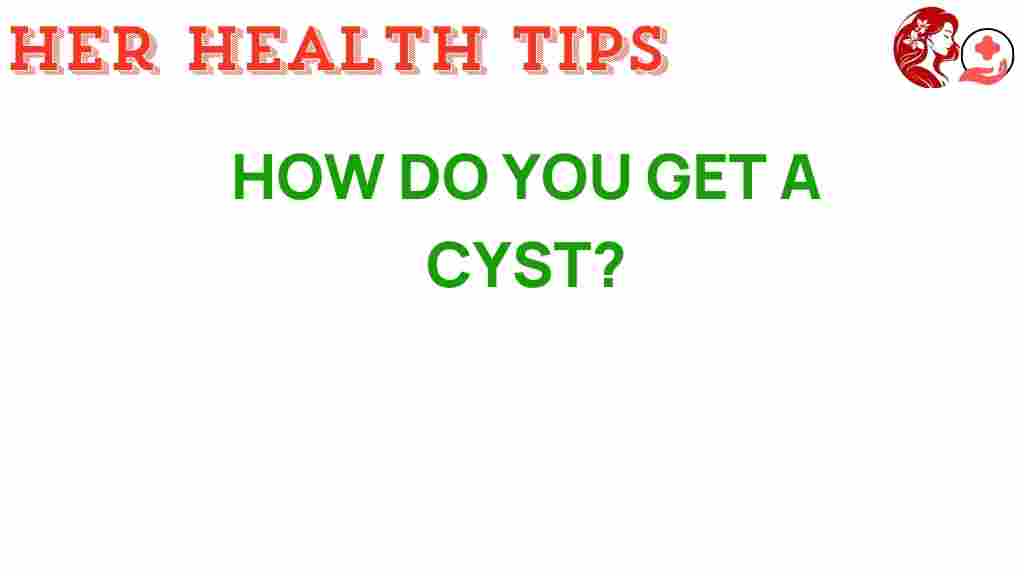Unraveling the Mystery: How Do You Get a Cyst? – Understanding Cyst Formation
Cysts are fluid-filled sacs that can develop in various parts of the body, often causing concern for those who find them. Understanding cyst formation is essential for maintaining good skin health and overall wellness. In this article, we will explore the causes of cysts, available treatment options, and tips for prevention. We will also provide valuable healthcare insights into related medical conditions and offer wellness advice for better skin care.
What is a Cyst?
A cyst is a closed sac-like structure that can be filled with fluid, semi-solid material, or gas. Cysts can form in any tissue of the body and vary in size. While many cysts are harmless and may not require treatment, some can lead to complications and should be evaluated by a healthcare professional.
Types of Cysts
There are several types of cysts, including:
- Epidermoid cysts: Commonly found on the skin, often due to clogged hair follicles.
- Pilar cysts: Similar to epidermoid cysts but typically found on the scalp.
- Sebaceous cysts: Formed from blocked sebaceous glands, usually filled with oily material.
- Baker’s cysts: Found behind the knee, often related to joint problems.
- Ovarian cysts: Develop in the ovaries and can be functional or pathological.
Understanding the Causes of Cysts
The causes of cysts can vary widely depending on the type of cyst and its location. Here are some common causes:
- Blocked ducts: Many cysts form when glands or ducts become blocked, leading to fluid accumulation.
- Infections: Some cysts develop as a response to infection, where the body creates a sac to isolate the affected area.
- Genetic conditions: Certain hereditary conditions can predispose individuals to developing multiple cysts.
- Inflammation: Chronic inflammation in the body can lead to cyst formation.
- Hormonal changes: Hormonal fluctuations, especially in women, can contribute to ovarian cysts.
How Cysts Form: A Step-by-Step Process
Understanding how cysts form can help demystify the condition:
- Initial Trigger: A blockage or disruption occurs in a gland or duct.
- Fluid Accumulation: Fluid begins to accumulate in the blocked area.
- Formation of a Sac: The body creates a membrane or sac around the fluid, forming a cyst.
- Growth: The cyst may grow in size as more fluid accumulates.
Treatment Options for Cysts
If you discover a cyst, it’s important to consult with a healthcare provider for an accurate diagnosis and appropriate treatment options. Here are some common approaches:
- Observation: Many cysts are harmless and may not require any treatment. Regular monitoring can be sufficient.
- Drainage: If a cyst becomes painful or infected, a healthcare provider may drain it to relieve discomfort.
- Surgical removal: For larger or recurrent cysts, surgical removal may be necessary.
- Medication: Antibiotics may be prescribed if the cyst is infected.
Home Remedies for Cysts
While it is essential to consult with a healthcare professional, some individuals may find relief through home remedies:
- Warm compresses: Applying a warm compress can reduce pain and promote drainage.
- Tea tree oil: This natural antiseptic may help reduce inflammation and prevent infection.
- Aloe vera: Known for its soothing properties, aloe vera can help with cysts on the skin.
Prevention Tips for Cyst Formation
Preventing cysts requires a proactive approach to skin health and overall wellness. Here are some effective prevention tips:
- Maintain good hygiene: Regular washing of the skin can prevent blockages in hair follicles.
- Manage skin conditions: Conditions like acne should be treated promptly to reduce the risk of cysts.
- Avoid tight clothing: Wearing loose-fitting clothes can reduce irritation and friction on the skin.
- Stay hydrated: Proper hydration supports skin health and can prevent dryness and blockages.
- Balanced diet: A diet rich in vitamins, minerals, and antioxidants can support overall skin health.
Healthcare Insights: When to Seek Help
Knowing when to seek healthcare advice is crucial. You should consult a healthcare professional if you notice:
- A cyst that is painful or growing rapidly.
- Redness or warmth around the cyst, indicating possible infection.
- Cysts that recur frequently.
- Any changes in the appearance or characteristics of a cyst.
For further reading on skin health and the importance of regular check-ups, visit this link.
Medical Conditions Related to Cysts
Several medical conditions can lead to cyst formation, including:
- Polycystic ovary syndrome (PCOS): A hormonal disorder causing multiple cysts in the ovaries.
- Gardner syndrome: A genetic disorder leading to the formation of cysts and tumors.
- Steatocystoma multiplex: A condition characterized by multiple sebaceous cysts.
Wellness Advice for Managing Cysts
Taking care of your skin and health is essential in managing cysts. Here are some wellness advice tips:
- Regular skin checks: Self-examination can help you notice changes early.
- Consult a dermatologist: Regular visits to a dermatologist can help you keep your skin healthy and prevent cysts.
- Stress management: Stress can impact overall health, including skin conditions, so find ways to manage stress effectively.
Conclusion
In summary, cysts are common formations that can arise due to various factors, including blocked ducts, infections, and genetic predispositions. Understanding the causes of cysts and how they form is vital for effective management and prevention. While many cysts are benign and require little to no treatment, seeking professional advice is crucial if you experience symptoms or have concerns about a cyst.
By maintaining good skin health, following prevention tips, and being aware of when to seek help, you can minimize the impact of cysts on your life. Remember, proactive care and attention to your skin can lead to better overall wellness.
For more insights into skin health and treatments, see this external resource.
This article is in the category Conditions and created by HerHealthTips Team
